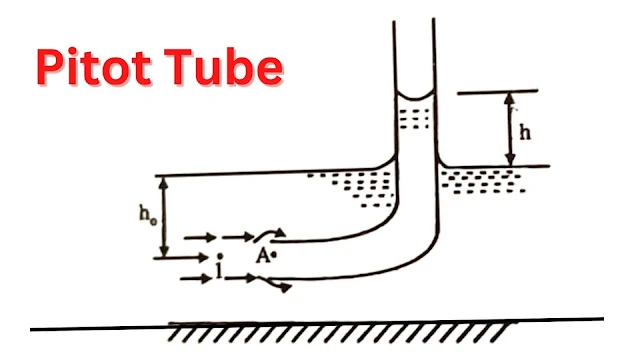The pitot tube is the simplest form of Bernoulli. It is used to measure the speed of fluid flow in an open tube. It is an L-shaped bent glass tube open at both ends.
Pitot Tube Working Principle
To measure the flow of a fluid, it is placed in the fluid in such a way that the short arm is opposite to the direction of the fluid and parallel to the flow of the fluid in the tube until all its kinetic energy is converted into potential energy.
Diagram Credit to: Unit Operation - ii (books) by k.A Gavhane
The liquid rises freely in the tube thus in a pitot tube the height above the free fluid plane of the tube will be the kinetic energy peak.
Pitot Tube Equation
Let the speed of liquid in the tube be (v)
ho = depth of free plane of lower end of a pitot tube
h = free top depth of liquid
The height of the fluid in the Pitot tube is at point A on the baseline and near and outside the Pitot tube.
Let the velocity of the flow of fluid at point (1) be (v) and v2 = 0 at A.
P1/ρg + v1²/2g + z1 = P2/ρg + v2²/2g + z1
P1/ρg + v1²/2g + ho = P2/ρg + 0 + (h +ho)
v2²/2g = h
v1² = 2gh
V1 = √2gh
Pitot tube formula
V1 = Cp√2gh
(Cp = .99 to .995)
Where Cp is the Coefficient of the pitot tube.
Advantages and disadvantages
Advantages
(i) It is Pitot tube low cost and economical.
(ii) It is a Pitot tube that can be easily installed.
(iii) It is permanent pressure loss is low.
Disadvantage
(i) It is difficult to separate points A and B properly.
(ii) It is difficult to keep the Pitot tube exactly parallel to the direction of fluid flow.
(iii) The pitot tube cannot accurately give the value of fluid velocity because the fluid column in the tube results in positive velocity and negative pressure (h) at the mouth of the tube.
Rotameter (Variable Area Meter)
By this, fluid flow is detected in such a pipe where pressure is constant, it is also called a variable area meter.
Rotameter Construction
It consists of a tapered tube of glass. Inside which a float is lying, the float vertical is free to move up and down. The float should be of a metal, it depends on the density of the flowing liquid.
A scale is fixed on the outside of the glass tube. From which the reading of float is read. At high temperatures, instead of glass, a metal tube is used for float, using this an indicator is taken out.
Rotameter Working Principle
When a fluid flows through a rotameter, the float moves upwards and the fluid passes through the glass tube from the float with angular velocity. In this situation, the float never stops in equilibrium because three forces act on it.
(i) Gravity Force (weight of the float) = MFg/g
(ii) Buoyant force acting to lift the float = Vρg
(iii) Difference pressure force = (P1 - P2)
A rotameter is used to measure
Rotameter is used in the chemical industry for the measurements of the flow rate of compressible and incompressible fluids.
Rotameter formula
For dynamic equilibrium of the float and force balance can be written
Net upward force = Net downward force
By density
ρf = 2ρ
Rotameter reading units
rotameter is units liters or gallons per minute


